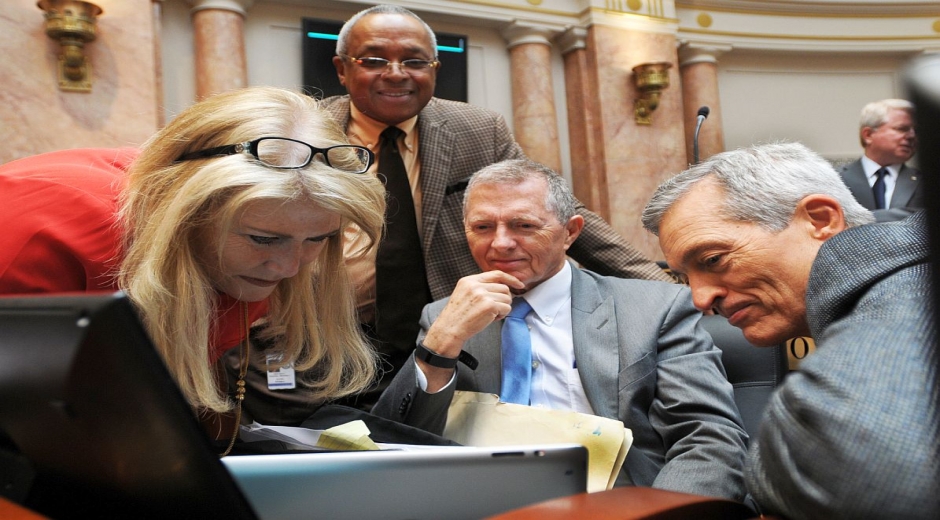
The Kentucky Legislature’s Final Week

Thomas McAdam
iLocalNews Louisville is your best source of news and information about Derby City.
- Professional Journalist
You were probably asleep when the biggest news of the week broke in Frankfort.
Though Capitol observers across the state had kept an eye on Frankfort news for days, awaiting a deal among lawmakers on the state’s next two-year budget, most people had long turned in for the night before that agreement was finally achieved around 2:30 a.m. on Thursday morning.
An impromptu, middle-of-the-night press conference that legislators held for a small group of reporters in the Capitol Annex was live-streamed online. A pair of live-streams of the event drew a grand total of 15 online viewers at that lonely hour of the night.
But as the sun rose on our commonwealth a few hours later, thousands of Kentuckians awoke to newscasts declaring that the budget impasse had been broken. Legislative leaders were quoted as predicting – accurately, as it turned out – that the compromise spending plan would pass the Senate and House before the 2016 legislative session adjourned the next day.
The news signaled some long-awaited certainty for a budget plan that had taken a winding journey. In its earliest incarnation, the proposal was unveiled in January as the governor’s spending proposal. Since then, both the House and Senate each approved their own versions of the spending plan.
But until this week’s compromise was achieved, no one could say for certain whether a plan could muster the support to pass into law, whether a partial government shutdown was on the horizon, or whether lawmakers might be called back into a special session at a later date to continue budget negotiations. Much uncertainty has been laid to rest.
The budget plan that lawmakers agreed to and officially approved in the Senate and House before adjourning the 2016 legislative session on Friday night represents a mixture of Senate and House priorities and compromises where the chambers met in the middle so that a budget could pass into law.
The approved budget can generally be described as one in which savings were sought wherever possible so that more money could go toward shoring up the state’s troubled public pension systems. In total, $1.284 billion in new funding is going toward pensions.
The 9 percent budget cuts the governor proposed for significant parts of the Executive Branch remain in the final version of the budget, though some keys areas – including the basic school-funding formula and Medicaid – are shielded from those cuts.
One of the biggest areas of focus in budget negotiations concerned postsecondary funding. The version of the budget plan proposed by the governor and the version passed by the Senate in March both proposed 9 percent cuts for public colleges and universities. The House plan, passed last month, called for no cuts. In the end, both chambers agreed upon a plan with a 4.5 percent reduction in spending for postsecondary schools, not including the state’s smallest public university, Kentucky State University, which was shielded from cuts.
Another highlight of the budget plan: Although coal counties typically have 50 percent of coal severance tax money returned to them, that percentage will go up to 60 percent over the next two years.
The budget was approved Friday evening on a 38-0 vote in the Senate. Later in the evening, the House gave its approval to the plan with a 98-1 vote. Shortly after, gavel strikes in the Senate and House officially brought the General Assembly’s 2016 session to a close just before midnight.
It’s possible that the budget might still see some more action in the days ahead, though. The state constitution gives the governor 10 days, not including Sundays, to issue vetoes. If he vetoes parts of the budget, lawmakers will not have the option of voting to override the vetoes since the legislative session has ended.
In addition to the budget, scores of other bills and resolutions were approved in this year’s session. Restoration of voting rights for some felons, informed consent measures that will require face-to-face meetings or real-time videoconference consultations with a medical professional for women seeking abortions, and an effort to crack down on drunken driving are among the pieces of legislation that will soon be added to the law books. Under the constitution, most bills – all that don’t contain emergency clauses or specify different effective dates – go into effect 90 days after a legislative session ends. That means mid-July is when a new batch of laws will starting having an impact on citizens across the state.
Until then, lawmakers are eager to hear feedback on this year’s session and receive input on which issues constituents still want to see tackled. You can share your thoughts with lawmakers by calling the General Assembly’s toll-free message line at 800-372-7181.
Photo: (From left) Rep. Diane St. Onge, R-Lakeside Park, Rep. Arnold Simpson, D-Covington, Rep. Thomas Kerr, R-Taylor Mill, and Rep. Jerry Miller, R-Louisville, review legislation in the Kentucky House of Representatives.
(Robert Weber, of the Kentucky Legislative Research Commission contributed to this article)

Gideon John Tucker (February 10, 1826 – July 1899) was an American lawyer, newspaper editor and politician. In 1866, as Surrogate of New York, he wrote in a decision of a will case (Final Accounting in the Estate of A.B., 1 Tucker 248, N.Y. Surr. 1866): "No man's life, liberty or property are safe while the Legislature is in session."